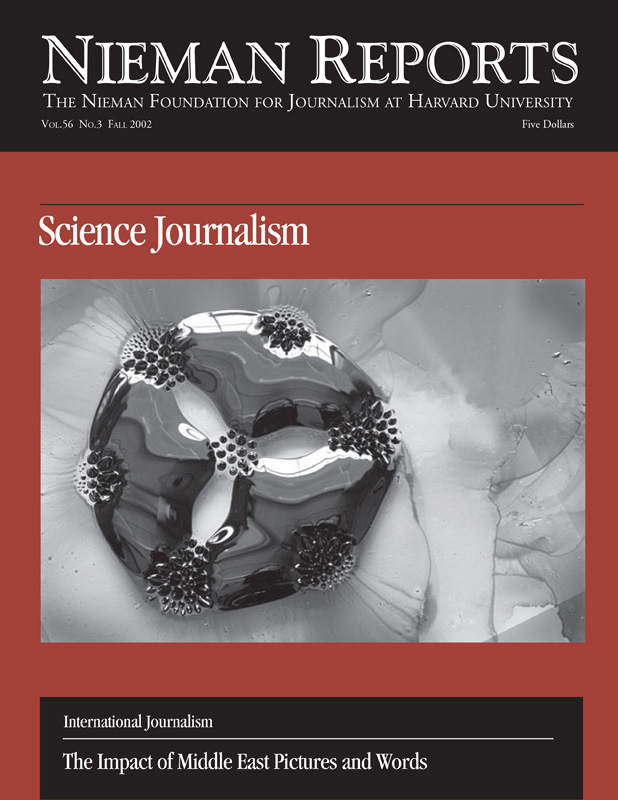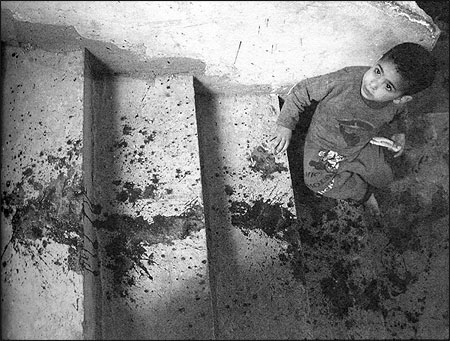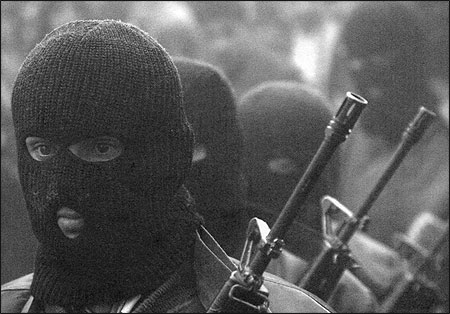The Palestinian child stares emptily from the foot of a bloodstained staircase, a half-eaten sandwich in his left hand, his right hand resting on a step leading to his house. Hours before, the boy’s father and grandfather had been shot to death amid yet another spasm of Middle East violence.
To the San Francisco Chronicle editors who had to decide which photograph would occupy the middle of the front page the next day, this was a searing image that conveyed emotion and the complexities of a conflict without end.
Many readers saw something else: proof of the paper’s anti-Israel bias. They called and wrote angrily, demanding to know why the paper persists in showing sympathetic images of Palestinian boys and girls while depicting only Israeli tanks and bulldozers. Where are the photographs showing the anguish of young Israelis as their friends and relatives are wantonly killed by suicide bombers? Where is the balance? The questions, which come in varying form from competing sides of the Mideast controversy, defy easy answers, in part because newspapers rarely take the time to step back and take a longer view of the impact of their coverage. Editors focus on the immediate decisions. What’s the best picture for tomorrow’s cover? Which six stories do we put on the front page? What’s our lead story?
Did this particular photo evoke sympathy for Palestinians, or at least for the Palestinian boy? No doubt. More importantly, did the decision to put the picture on Page One betray a pattern of bias on the paper’s part?
In my role as the Chronicle’s ombudsman, I needed to respond to these questions and concerns. But rather than decide for myself, I invited five readers to examine our Mideast photo coverage during a three-month period, from December 23, 2001 until March 15, 2002. Each reader looked at copies of the same 79 photos and judged whether the images were sympathetic toward Palestinians or Israel or neutral. The package of photos included captions, the page and section in which the pictures ran, photo credits, and publication dates.
The readers were selected by Heidi Swillinger, a copyeditor who developed our “Two Cents” program, a database of roughly 1,100 readers who agreed to offer comment or expertise on a wide range of subjects, usually involving reactions to breaking news. The only criteria were that our volunteers could spare several hours and that they were not activists in Mideast affairs.
Before the judging, we asked them to tell us a little about themselves and their views of the Mideast situation:
Each member of the panel separated the photos into three categories: sympathetic to Palestinians, sympathetic to Israel, and neutral.
Here is what they saw:
After they’d made these judgments, we asked the panel members for their impressions.
The San Francisco architect, who felt that Palestinians had been provoked into brutality because of brutal treatment by Israel, found that similar photographs could be interpreted very differently, partly because of the way the conflict has been framed in the media. “Israelis with guns are soldiers defending their people,” he said, “while Palestinians with guns are terrorists.” He added that “very few Palestinian men [were] photographed sympathetically.”
The retired nurse, who described herself as “firmly pro-Zionist,” said, “after seeing the pictures I feel your coverage is actually fairly balanced. The pictures I considered pro-Palestinian seemed to pull far more emotional response than the pro-Israeli ones, but that’s largely an artifact of the fact that the Israelis have more equipment and infrastructure, and … are more able to supervise and protect their children [from photographers].”
The retired Redwood city resident who advocates a pullback to the 1967 borders said, “it appears that the majority of these pictures are sympathetic toward the Palestinians in a sense—although a number of Palestinian bomb attacks are depicted, it seems that in these pictures the Israelis have created the most deaths.”
The San Francisco community service volunteer was “totally surprised by this ‘test.’ At the beginning I felt the S.F. Chronicle was biased toward the Palestinians. Then, as I went through more and more, I wrote ‘neutral’ more than I thought I would. Did I get desensitized? It feels that way, quite honestly. My final thought is a bit of a contrast—while I certainly indicated ‘neutral’ more than the other two categories, I also came away with a feeling that the Chronicle leans toward a sympathetic view of the Palestinians. Interesting how a group of photos can alter your perspective versus viewing a single photo.”
Context means a lot, this reader told us. “I found that I read the captions more closely today than when I read the paper at home,” he said. “The wording of the captions influenced me in determining whether there was a bias. Had I just seen the photos without captions, I would have found less bias.”
From five readers, we received five different reactions, but when looked at together, the responses yield an interesting result—their findings were almost equally distributed.
There’s nothing scientific in what we did and nothing that would hold up in court—or even in a debate with an avidly pro-Palestinian or pro-Israel reader. But the experiment had value to the newspaper. For one thing, we stepped back and took the time to look at one aspect of our work as it appeared over time. It reminded photo editors and senior editors that day-today news decisions have lasting impacts on how readers view the paper. And it prompted at least one photo editor to think more deeply about her choices as she waded through hundreds of Mideast photos each day.
“We always look for photos that are compelling and elicit an emotional response,” said Elizabeth Mangelsdorf, acting director of photography. “But the readers’ response to our Mideast photo coverage has reminded us that we have to look hard at why and how we run photos. We need to show both sides of a conflict. But individual events can appear more sympathetic to one side or the other in the coverage of a long-term conflict. Because of this, it’s important that, over time, we seek balance in the photos we choose.”
The experiment showed something else: If the Chronicle was trying to espouse a particular viewpoint through photo selections, it wasn’t doing a very good job.
Dick Rogers is the San Francisco Chronicle’s readers’ representative and a 28-year newspaper veteran. Since his department was created last October, he has fielded comment from more than 4,000 readers on issues ranging from the quality of the paper’s comics page to the effectiveness of prostate cancer screening, the debate over allowing unleashed dogs in urban parks, and coverage of the Middle East.
To the San Francisco Chronicle editors who had to decide which photograph would occupy the middle of the front page the next day, this was a searing image that conveyed emotion and the complexities of a conflict without end.
Many readers saw something else: proof of the paper’s anti-Israel bias. They called and wrote angrily, demanding to know why the paper persists in showing sympathetic images of Palestinian boys and girls while depicting only Israeli tanks and bulldozers. Where are the photographs showing the anguish of young Israelis as their friends and relatives are wantonly killed by suicide bombers? Where is the balance? The questions, which come in varying form from competing sides of the Mideast controversy, defy easy answers, in part because newspapers rarely take the time to step back and take a longer view of the impact of their coverage. Editors focus on the immediate decisions. What’s the best picture for tomorrow’s cover? Which six stories do we put on the front page? What’s our lead story?
Caption: A Palestinian boy sits on a staircase stained with blood at a house in the Jabalya refugee camp March 12, 2002. Family members said that the boy’s father, Waled Izz el-Din, and grandfather, Abdel Rahman, were killed by gunfire as the violence, which has claimed the lives of at least 37 Palestinians and Israelis in the region over the past 24 hours, continued unabated.
Photo Credit: Reuters
Publication Date: 3/13/2002
Each member of the readers’ panel was also told the page and section in which this photo was published in color. The panel saw the photo in black and white.
In their responses, four readers considered this photo to be pro-Palestinian, one thought it neutral. Photo courtesy of Ahmed Jadallah/Reuters.
Did this particular photo evoke sympathy for Palestinians, or at least for the Palestinian boy? No doubt. More importantly, did the decision to put the picture on Page One betray a pattern of bias on the paper’s part?
In my role as the Chronicle’s ombudsman, I needed to respond to these questions and concerns. But rather than decide for myself, I invited five readers to examine our Mideast photo coverage during a three-month period, from December 23, 2001 until March 15, 2002. Each reader looked at copies of the same 79 photos and judged whether the images were sympathetic toward Palestinians or Israel or neutral. The package of photos included captions, the page and section in which the pictures ran, photo credits, and publication dates.
The readers were selected by Heidi Swillinger, a copyeditor who developed our “Two Cents” program, a database of roughly 1,100 readers who agreed to offer comment or expertise on a wide range of subjects, usually involving reactions to breaking news. The only criteria were that our volunteers could spare several hours and that they were not activists in Mideast affairs.
Caption: A priest prays while children light candles at the Grotto, believed to be the birthplace of Jesus Christ, in the West Bank town of Bethlehem, Sunday, December 23, 2001. The Mideast fighting has dealt a crushing blow to Bethlehem, where the 30,000 Palestinian residents are roughly half-Muslim and half-Christian. The town, just south of Jerusalem, is heavily dependent on Christian tourists from around the world.
Photo Credit: AP Photo/Karel PrinslooPublication Date: 12/24/2002
Each member of the readers’ panel was also told the page and section in which this black-and-white photo was published.
In their responses, all five readers thought this image was neutral. Photo courtesy of Karel Prinsloo/The Associated Press.
Before the judging, we asked them to tell us a little about themselves and their views of the Mideast situation:
- A 49-year-old architect and San Francisco resident. He was “both sympathetic and critical of both sides in this conflict.” He added that Palestinians have been “treated brutally by Israel and that they have been provoked into equally brutal reactions.”
- A 66-year-old Berkeley resident and retired registered nurse. “I feel that anti-Semitism is like the Hydra,” she said. “The more of its heads are cut off, the more grow back.” She said she believes Arab states have “refused to provide aid to Palestinians to foment anti-Israeli sentiment.”
- A 79-year old retired man, living in Redwood City. He doubted that the Mideast situation would be resolved in our lifetimes. “I have always felt that Israel was given a parcel of land that did not originally belong to them,” he said. “I’m now inclined to agree with the Saudi proposal of reverting to the 1967 land division.”
- A 45-year-old community service volunteer from San Francisco. She, too, said she believed the situation defied resolution. While Israel must take some responsibility, she said, “it is hard for me to find complete sympathy (empathy) for the Palestinians. How do you accept suicide bombers?” she asked. “How do you accept bombings on High Holy Days? How do you reconcile Barak’s peace plan being utterly refused by Arafat?”
- A 50-year-old San Francisco insurance consultant. He concluded that factions on both sides in the Middle East prevent an everlasting peace, and he viewed the motives of both sides skeptically. “I believe Israel would like an all-out war to settle the issue for the most part before the Arabs get a nuclear weapon,” he said. “I believe the Palestinians want an all-out war to foster unity among all non-Jewish-supported countries.”
Each member of the panel separated the photos into three categories: sympathetic to Palestinians, sympathetic to Israel, and neutral.
Here is what they saw:
| Reader | Pro-Palestinian | Neutral | Pro-Israel |
| #1 | 21 | 10 | 48 |
| #2 | 32 | 22 | 25 |
| #3 | 35 | 15 | 29 |
| #4 | 24 | 47 | 8 |
| #5 | 18 | 45 | 16 |
After they’d made these judgments, we asked the panel members for their impressions.
The San Francisco architect, who felt that Palestinians had been provoked into brutality because of brutal treatment by Israel, found that similar photographs could be interpreted very differently, partly because of the way the conflict has been framed in the media. “Israelis with guns are soldiers defending their people,” he said, “while Palestinians with guns are terrorists.” He added that “very few Palestinian men [were] photographed sympathetically.”
The retired nurse, who described herself as “firmly pro-Zionist,” said, “after seeing the pictures I feel your coverage is actually fairly balanced. The pictures I considered pro-Palestinian seemed to pull far more emotional response than the pro-Israeli ones, but that’s largely an artifact of the fact that the Israelis have more equipment and infrastructure, and … are more able to supervise and protect their children [from photographers].”
The retired Redwood city resident who advocates a pullback to the 1967 borders said, “it appears that the majority of these pictures are sympathetic toward the Palestinians in a sense—although a number of Palestinian bomb attacks are depicted, it seems that in these pictures the Israelis have created the most deaths.”
The San Francisco community service volunteer was “totally surprised by this ‘test.’ At the beginning I felt the S.F. Chronicle was biased toward the Palestinians. Then, as I went through more and more, I wrote ‘neutral’ more than I thought I would. Did I get desensitized? It feels that way, quite honestly. My final thought is a bit of a contrast—while I certainly indicated ‘neutral’ more than the other two categories, I also came away with a feeling that the Chronicle leans toward a sympathetic view of the Palestinians. Interesting how a group of photos can alter your perspective versus viewing a single photo.”
Context means a lot, this reader told us. “I found that I read the captions more closely today than when I read the paper at home,” he said. “The wording of the captions influenced me in determining whether there was a bias. Had I just seen the photos without captions, I would have found less bias.”
From five readers, we received five different reactions, but when looked at together, the responses yield an interesting result—their findings were almost equally distributed.
| Pro-Palestinian | Neutral | Pro-Israel | |
| 5 Readers | 130 | 139 | 126 |
There’s nothing scientific in what we did and nothing that would hold up in court—or even in a debate with an avidly pro-Palestinian or pro-Israel reader. But the experiment had value to the newspaper. For one thing, we stepped back and took the time to look at one aspect of our work as it appeared over time. It reminded photo editors and senior editors that day-today news decisions have lasting impacts on how readers view the paper. And it prompted at least one photo editor to think more deeply about her choices as she waded through hundreds of Mideast photos each day.
Caption: Palestinian gunmen march during the funeral procession of Palestinian police officers Omar Wahdan, 20, and Hussein Zbidi, 35, who were shot dead by Israeli forces while participating in a gunfight Monday, in the West Bank town of Ramallah Tuesday, January 22, 2002.Photo Credit: AP
Publication Date: 1/23/2002
Each member of the readers’ panel was also told the page and section in which this black-and-white photo was published.
In their responses, reactions were mixed. One reader thought this photo was pro-Palestinian; two readers thought it was pro-Israel, and two readers thought it was neutral. Photo courtesy of Zoom77/The Associated Press.
“We always look for photos that are compelling and elicit an emotional response,” said Elizabeth Mangelsdorf, acting director of photography. “But the readers’ response to our Mideast photo coverage has reminded us that we have to look hard at why and how we run photos. We need to show both sides of a conflict. But individual events can appear more sympathetic to one side or the other in the coverage of a long-term conflict. Because of this, it’s important that, over time, we seek balance in the photos we choose.”
The experiment showed something else: If the Chronicle was trying to espouse a particular viewpoint through photo selections, it wasn’t doing a very good job.
Dick Rogers is the San Francisco Chronicle’s readers’ representative and a 28-year newspaper veteran. Since his department was created last October, he has fielded comment from more than 4,000 readers on issues ranging from the quality of the paper’s comics page to the effectiveness of prostate cancer screening, the debate over allowing unleashed dogs in urban parks, and coverage of the Middle East.






